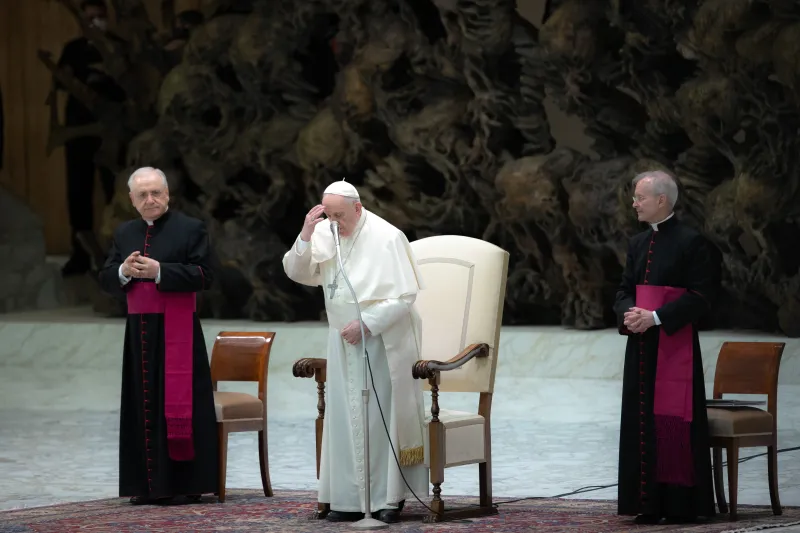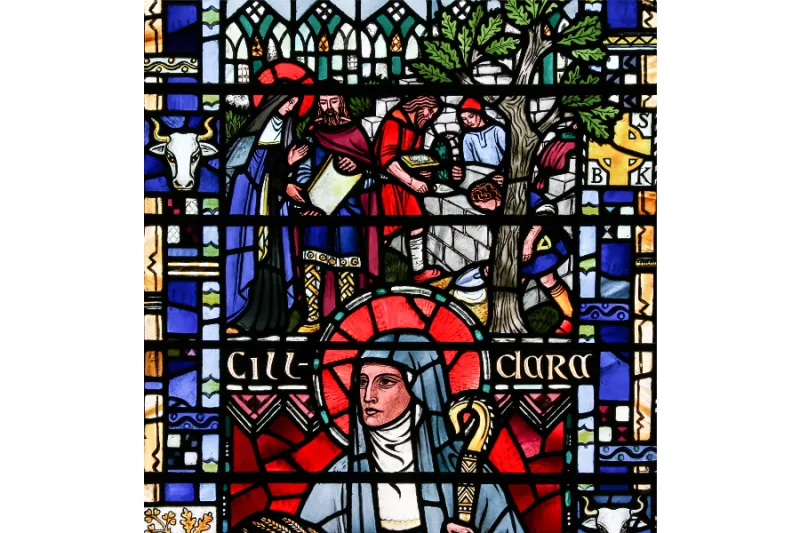
Pope Francis: Christ is the bond uniting the communion of saints
 Pope Francis prays at his General Audience in the Vatican’s Paul VI Hall, Feb. 2, 2022. / Daniel Ibañez/CNA.
Pope Francis prays at his General Audience in the Vatican’s Paul VI Hall, Feb. 2, 2022. / Daniel Ibañez/CNA.
Washington, D.C. Newsroom, Feb 2, 2022 / 10:36 am (CNA).
Pope Francis prayed for the Burmese people and for the success of the upcoming Winter Olympics during his general audience on Wednesday.
He first provided a brief catechesis on St. Joseph and the communion of saints Feb. 2, saying that “Even when we rely fully on the intercession of a saint, or even more so that of the Virgin Mary, our trust only has value in relation to Christ. As if the path toward this saint or toward Our Lady does not end there, no. Not there, but in relationship with Christ. He is the bond, Christ is the bond that unites us to him and to each other, and which has a specific name: this bond that unites us all, between ourselves and us with Christ, it is the ‘communion of saints’.”
Devotion to the saints, he said, is “simply talking to a brother, a sister, who is in the presence of God, who has led a righteous life, a model life, and is now in the presence of God. And I talk to this brother, this sister, and ask for their intercession for the needs that I have.”
He shared a prayer to St. Joseph he has recited daily for 40 years, and which he said came from a late 18th century prayer book of the Sisters of Jesus and Mary: “Glorious Patriarch Saint Joseph, whose power makes the impossible possible, come to my aid in these times of anguish and difficulty. Take under your protection the serious and troubling situations that I commend to you, that they may have a happy outcome. My beloved father, all my trust is in you. All my trust is in you. Let it not be said that I invoked you in vain, and since you can do everything with Jesus and Mary, show me that your goodness is as great as your power. Amen.”
After his catechesis, Pope Francis issued appeals for prayers on a multitude of international issues.
“For a year now, we have been watching the violence in Myanmar with sorrow. I echo the appeal of the Burmese bishops for the international community to work for reconciliation between the parties concerned,” said Pope Francis.
Myanmar, which is also called Burma, is home to a small Catholic population. Despite their small numbers, Catholics have played a sizeable role in the protests throughout the country since a military coup seized power last year.
“We cannot look away from the suffering of so many brothers and sisters. Let us ask God in prayer for consolation for this tormented population,” he said. “To him we entrust our efforts for peace.”
Pope Francis noted that the 2022 Winter Olympics begin on Thursday, Feb. 4, and that the Paralympic Winter Games are set to commence on March 4.
“I warmly greet all participants. I wish the organizers every success and the athletes the very best,” he said.
The pope added that the “universal language” of sports can serve as a way of building “friendship and solidarity between individuals and peoples of all cultures and religions.” He said that he is hopeful “that the Olympic Games may bring about a more fraternal world.”
The feats of disabled athletes, said Pope Francis, provide an example that “helps everyone to overcome prejudices and fears” and help to “make our communities more welcoming and inclusive.”
“This is the real gold medal,” he said.
“I also follow with attention and emotion the personal stories of refugee athletes. May their testimonies help to encourage civil societies to open up with ever greater confidence to all, leaving no one behind.”
During the Summer Olympics in Tokyo, a 29-member team of refugee athletes competed under the Olympic flag. However, the Refugee Olympic Team will not be competing at the considerably-smaller Winter Olympics.
“I wish the great Olympic and Paralympic family a unique experience of human brotherhood and peace: blessed are the peacemakers,” he said.
On Feb. 4, the world will acknowledge the second-ever “International Day of Human Brotherhood.”
It is a reason for satisfaction that the nations of the entire world are joining in this celebration, aimed at promoting interreligious and intercultural dialogue, as also called for in the Document on Human Brotherhood and for World Peace and Common Coexistence, signed on 4 February 2019 in Abu Dhabi, by the Grand Imam of Al-Azhar, Muhammad Aḥmad al-Tayyib, and by myself,” said Pope Francis.
“Brotherhood,” said the pope, “means reaching out to others, respecting them and listening to them with an open heart.”
Pope Francis hopes that in the future, “concrete steps will be taken together with the believers of other religions, and also with people of good will, to affirm that today is a time of brotherhood, avoiding fuelling clashes, divisions, and closures.”
“Let us pray and commit ourselves every day so that we can all live in peace, as brothers and sisters,” he said.





